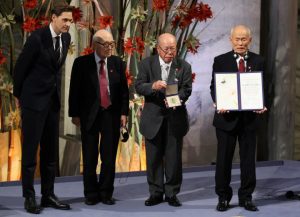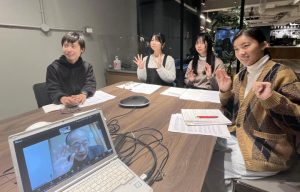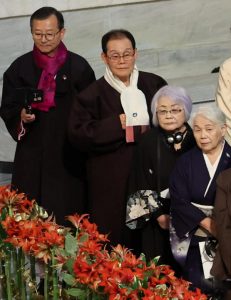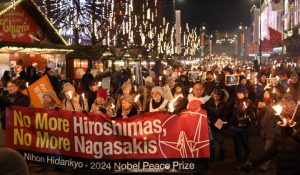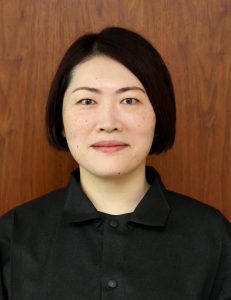Junior Writers Reporting: Interviews with people who visited Oslo in Norway at the time of the Nobel Peace Prize award ceremony
Feb. 11, 2025
On December 10 last year, the Japan Confederation of A- and H-Bomb Sufferers Organizations (Nihon Hidankyo), the national organization of A-bomb survivors (hibakusha), received the Nobel Peace Prize. At the award ceremony held in Oslo, Norway, Terumi Tanaka, 92, co-chair of Nihon Hidankyo, delivered an acceptance speech in which he urged the international community to carry out activities toward the elimination of nuclear weapons saying, “Let not humanity destroy itself with nuclear weapons!” In conjunction with the ceremony, many A-bomb survivors and Japanese citizens visited the site, too. What did they feel and what kind of determination did they reaffirm while they were in Oslo? Junior writers from the Chugoku Shimbun interviewed them.
Toshiyuki Mimaki, chair of Hiroshima Hidankyo
He has been disappointed with the Japanese government for its negative attitude toward TPNW
Three A-bomb survivors went on stage for the ceremony. One of them, Toshiyuki Mimaki, 82, co-chair of Nihon Hidankyo also serving as chair of Hiroshima Hidankyo, received an award certificate. He said, “It was hefty.”
On the stage, Mr. Mimaki remembered his “predecessors,” who previously supported Hidankyo’s activities, including Ichiro Moritaki, Sunao Tsuboi, Doctor Shuntaro Hida, Sumiteru Taniguchi who had survived the atomic bombing in Nagasaki. He said, “They must have faced huge difficulties in forming an organization and staging campaigns from scratch. We are now here as a result of the long history of our organization.” On the day of the ceremony, he had photos of those predecessors in his chest pocket.
On the night of the award ceremony, a torchlight procession was held to honor the prize winner. He felt Hidankyo’s winning the prize was celebrated nationwide. But after returning to Japan, he has become keenly aware of a harsh reality.
In the beginning of the year, he met with Prime Minister Shigeru Ishiba at the prime minister’s office in Tokyo. Mr. Ishiba is not positive about Japan’s participation in the Treaty on the Prohibition of Nuclear Weapons (TPNW). It is because Japan follows a policy of reliance on “U.S. nuclear umbrella,” which is underpinned by the idea that the U.S. nuclear weapons are necessary to keep its national security.
When the prime minister was asked if Japan would participate in the third meeting of states parties to TPNW to be held in March as an observer, “He even did not say ‘I will think about it,’ Mr. Mimaki said. Implicitly expressing his disappointment and anger, Mr. Mimaki talked about his expectation for young people, by saying “If you start making a step forward to war, you cannot put on the brakes. You must be opposed to it at any cost.”
This is an international treaty which completely bans the manufacturing of nuclear weapons, possession of nuclear weapons, providing such weapons to other nations, or receiving them. At present, 73 nations and regions have signed the TPNW. Though Japan is the A-bombed nation, it is not willing to sign it.
States parties to the treaty would assemble at the third states parties meeting, which will be held at United Nations headquarters beginning March 3, this year. In cases where a nation does not sign the TPNW, it is possible for that nation to join as an observer upon its request, and such a nation is able to offer an opinion. Nihon Hidankyo and other organizations have strongly urged the Japanese government to join the TPNW states parties meeting at least as an observer, but the government’s policy is to not participate.
Jiro Hamasumi, deputy secretary general of Nihon Hidankyo
“Elimination of nuclear weapons” was not the only appeal made by Terumi Tanaka, co-chair of Nihon Hidankyo, in his speech at the ceremony. Mr. Tanaka first mentioned two basic demands of the atomic bomb survivors advocated by Nihon Hidankyo. He added an ad-libbed remark to the speech, saying “I would like you to know the fact that the Japanese government has not provided any compensation for the victims who died from the atomic bombing at all.” What does this exactly mean? The junior writers interviewed Jiro Hamasumi, 79, deputy secretary general of Hidankyo who lives in Inagi, Tokyo, and asked that question.
The first demand is that the state should compensate victims for the damage caused by the atomic bombs, because it is never forgivable to endure the sacrifice of war started and carried out by the government. The second demand is “the abolition of nuclear weapons.” Mr. Hamasumi said, “These are like the two wheels on the same axle for us in order to not have the national government stage war and to not have more hibakusha again.”
Relief measures are provided for the A-bomb survivors such as allowances and coverage of medical expenses. In 1994, the Atomic Bomb Survivors Relief Law went into effect. But it was a system intended to “relieve” the “survivors,” rather than provide “compensation” from the national government for taking responsibility of having started the war. Therefore, citizens who died instantly or some years after the bombing, victims’ children who did not experience the bombing in person but were orphaned by the bombing, and many of the surviving family members of A-bomb victims have received nothing from the government. “Hibakusha” are not the only “people who were victimized by the atomic bombing.”
We, the junior writers, also read “Message to the World,” a declaration delivered by Nihon Hidankyo in 1956 when it was founded. Mr. Hamasumi emphatically said, “Hibakusha were not able to testify their experiences from soon after the bombing. I want other people to understand the survivors came together to act while they had struggles, angers, and anguish experienced individually for eleven years after the war ended.”
Mr. Hamasumi experienced the atomic bombing of Hiroshima in the womb of his mother who was then 3-months pregnant. His father was killed by the bombing about 500 meters from the hypocenter. Only some of his belongings such as a belt buckle were left as relics. About 30 of his relatives evacuated to his home in Yaga (now part of Higashi Ward, Hiroshima). He remembered his three-year old cousin and others then suddenly became ill and died.
About twenty years ago, he formed a group of A-bomb survivors in Inagi. Since joining the national association of in-utero A-bomb survivors in 2014, he has also been engaged in activities such as writing a memoir of his experience. In 2019, he spoke at United Nations headquarters, and conveyed to the people of the world his suffering as a person with constant health burdens, “who was a hibakusha even before birth.”
According to Mr. Hamasumi, Mr. Tanaka’s ad-libbed remark in the speech about no government compensation for deaths of the atomic bombing, was also delivered as a question asking if damages are appropriately compensated in the wars at present. Now, some countries in the world have been conducting wars without taking responsibilities for the sacrifices of civilians.
Jeong Wonsul, chair of the South Korean Atomic Bomb Sufferers Association
One of the delegation members from Nihon Hidankyo attending the award ceremony was Jeong Wonsul, 81, a South Korean who experienced the atomic bombing in Hiroshima. Mr. Jeong is chair of the South Korean Atomic Bomb Sufferers Association. With the hope the presence of South Korean hibakusha is broadly known to others, he wore a “hanbok,” a Korean traditional costume, and sat down at the front row during the ceremony.
Some Koreans experienced the atomic bombing, because many people had come to Japan from the Korean Peninsula due to their poor living conditions in Korea, recruitment, or military draft from Japan, since the peninsula was colonized by Japan in 1910. Mr. Jeong, who was one-year-old at the time of the bombing, does not remember it.
After Japan’s defeat in war, many Koreans in Japan went back to the Korean Peninsula like Mr. Jeong. He suffered various discriminations in Japan, but even after his return to the home country, he faced a lack of understanding from people around him about a sickness caused by the atomic bomb’s radiation.
In the past, there was a gap in relief provided between A-bomb survivors living outside Japan and those in Japan. For example, the overseas survivors were not eligible for receiving the allowance survivors in Japan could receive. Supported by citizens and survivors in Japan, the survivors living overseas have made an appeal to the Japanese government, by arguing “Regardless of the place where we are, hibakusha are always hibakusha,” and filled in the gap step-by-step.
Mr. Jeong sent a message from South Korea to the junior writers, “Please listen to the A-bomb survivors who have been plagued by the atomic bombing physically and psychologically, and inherit their wishes.” We need to study history more. Also, we have to get to know about hibakusha in other nations and damages from the nuclear tests carried out abroad.
Kuniko Watanabe, NPO director
Kuniko Watanabe, 44, director of ANT-Hiroshima, the Non-Profit Organization (NPO) based in Naka Ward, Hiroshima, visited Oslo with about 50 hibakusha, separate from the Nihon Hidankyo delegation. In supporting the elderly participants, she delivered seeds of A-bombed trees and took part in a torchlight procession in Oslo.
We, the junior writers, imagined Ms. Watanabe visited Oslo with joy, but she said, “I was not in a light-hearted mood.” Nihon Hidankyo won the prize in midst of a situation where the nuclear-armed nations have turned to military buildup and where threats of nuclear weapon use are repeatedly made. The participants from her group were busy working on activities such as testifying about their atomic bombing experiences or handing over paper cranes to the local people, when they had spare time.
Ms. Watanabe watched the award ceremony via live-stream at a library near the ceremony venue. She recalled a time when she listened to a speech from Terumi Tanaka, co-chair of Nihon Hidankyo, who denounced Japanese government twice for its refusal to provide national compensation for the A-bomb victims, and said, “His speech conveyed hibakusha’s bitter disappointment and sorrow, which made me cry, too.”
Ms. Watanabe told us she also remembered the faces of some deceased hibakusha she had met with up until that time, such as the late Keiji Nakazawa, author of “Barefoot Gen,” the manga featuring the atomic bombing, and the late Kiyoko Imori, who had experienced the atomic bombing at Honkawa National School (now Honkawa Elementary School), the nearest school from the hypocenter. She added, “The Nobel Peace Prize is an award presented to all hibakusha, including those who had expressed their anger for the world situation related to nuclear weapons, and fought against the national government.”
The above article was written by the following junior writers:
Mei Kobayashi, 18; Yukari Kobayashi, 17; Riko Soma, 17; Manami Nakano, 17; Karin Fujiwara, 17; Misuzu Mori, 17; Mayu Yoshida 17; Natsumi Ozeki 16; Shino Shincho, 16; Miu Toda 16; Yuko Yamashita, 16; Natsuki Yamashiro, 16; Shosei Kamei, 15; Gaku Kawanabe, 15; Mai Nishitani, 15; Terukazu Yazawa, 15; Haruki Yukitomo, 15; Emi Ishi, 14; Mai Kobayashi, 14; Ayako Yamashita, 14; Ryunosuke Okamoto, 12; Rio Soma, 12; Kisho Morimoto, 13.
(Originally published on February 11, 2025)
Coming onto the stage, he recalled hardships of his predecessors
Toshiyuki Mimaki, chair of Hiroshima Hidankyo
He has been disappointed with the Japanese government for its negative attitude toward TPNW
Three A-bomb survivors went on stage for the ceremony. One of them, Toshiyuki Mimaki, 82, co-chair of Nihon Hidankyo also serving as chair of Hiroshima Hidankyo, received an award certificate. He said, “It was hefty.”
On the stage, Mr. Mimaki remembered his “predecessors,” who previously supported Hidankyo’s activities, including Ichiro Moritaki, Sunao Tsuboi, Doctor Shuntaro Hida, Sumiteru Taniguchi who had survived the atomic bombing in Nagasaki. He said, “They must have faced huge difficulties in forming an organization and staging campaigns from scratch. We are now here as a result of the long history of our organization.” On the day of the ceremony, he had photos of those predecessors in his chest pocket.
On the night of the award ceremony, a torchlight procession was held to honor the prize winner. He felt Hidankyo’s winning the prize was celebrated nationwide. But after returning to Japan, he has become keenly aware of a harsh reality.
In the beginning of the year, he met with Prime Minister Shigeru Ishiba at the prime minister’s office in Tokyo. Mr. Ishiba is not positive about Japan’s participation in the Treaty on the Prohibition of Nuclear Weapons (TPNW). It is because Japan follows a policy of reliance on “U.S. nuclear umbrella,” which is underpinned by the idea that the U.S. nuclear weapons are necessary to keep its national security.
When the prime minister was asked if Japan would participate in the third meeting of states parties to TPNW to be held in March as an observer, “He even did not say ‘I will think about it,’ Mr. Mimaki said. Implicitly expressing his disappointment and anger, Mr. Mimaki talked about his expectation for young people, by saying “If you start making a step forward to war, you cannot put on the brakes. You must be opposed to it at any cost.”
[Treaty on the Prohibition of Nuclear Weapons (TPNW) ]
This is an international treaty which completely bans the manufacturing of nuclear weapons, possession of nuclear weapons, providing such weapons to other nations, or receiving them. At present, 73 nations and regions have signed the TPNW. Though Japan is the A-bombed nation, it is not willing to sign it.
States parties to the treaty would assemble at the third states parties meeting, which will be held at United Nations headquarters beginning March 3, this year. In cases where a nation does not sign the TPNW, it is possible for that nation to join as an observer upon its request, and such a nation is able to offer an opinion. Nihon Hidankyo and other organizations have strongly urged the Japanese government to join the TPNW states parties meeting at least as an observer, but the government’s policy is to not participate.
“Seeking compensation for A-bomb deaths from the government” and “nuclear abolition” are two wheels on the same axle for Hidankyo’s activities
Jiro Hamasumi, deputy secretary general of Nihon Hidankyo
“Elimination of nuclear weapons” was not the only appeal made by Terumi Tanaka, co-chair of Nihon Hidankyo, in his speech at the ceremony. Mr. Tanaka first mentioned two basic demands of the atomic bomb survivors advocated by Nihon Hidankyo. He added an ad-libbed remark to the speech, saying “I would like you to know the fact that the Japanese government has not provided any compensation for the victims who died from the atomic bombing at all.” What does this exactly mean? The junior writers interviewed Jiro Hamasumi, 79, deputy secretary general of Hidankyo who lives in Inagi, Tokyo, and asked that question.
The first demand is that the state should compensate victims for the damage caused by the atomic bombs, because it is never forgivable to endure the sacrifice of war started and carried out by the government. The second demand is “the abolition of nuclear weapons.” Mr. Hamasumi said, “These are like the two wheels on the same axle for us in order to not have the national government stage war and to not have more hibakusha again.”
Relief measures are provided for the A-bomb survivors such as allowances and coverage of medical expenses. In 1994, the Atomic Bomb Survivors Relief Law went into effect. But it was a system intended to “relieve” the “survivors,” rather than provide “compensation” from the national government for taking responsibility of having started the war. Therefore, citizens who died instantly or some years after the bombing, victims’ children who did not experience the bombing in person but were orphaned by the bombing, and many of the surviving family members of A-bomb victims have received nothing from the government. “Hibakusha” are not the only “people who were victimized by the atomic bombing.”
We, the junior writers, also read “Message to the World,” a declaration delivered by Nihon Hidankyo in 1956 when it was founded. Mr. Hamasumi emphatically said, “Hibakusha were not able to testify their experiences from soon after the bombing. I want other people to understand the survivors came together to act while they had struggles, angers, and anguish experienced individually for eleven years after the war ended.”
Mr. Hamasumi experienced the atomic bombing of Hiroshima in the womb of his mother who was then 3-months pregnant. His father was killed by the bombing about 500 meters from the hypocenter. Only some of his belongings such as a belt buckle were left as relics. About 30 of his relatives evacuated to his home in Yaga (now part of Higashi Ward, Hiroshima). He remembered his three-year old cousin and others then suddenly became ill and died.
About twenty years ago, he formed a group of A-bomb survivors in Inagi. Since joining the national association of in-utero A-bomb survivors in 2014, he has also been engaged in activities such as writing a memoir of his experience. In 2019, he spoke at United Nations headquarters, and conveyed to the people of the world his suffering as a person with constant health burdens, “who was a hibakusha even before birth.”
According to Mr. Hamasumi, Mr. Tanaka’s ad-libbed remark in the speech about no government compensation for deaths of the atomic bombing, was also delivered as a question asking if damages are appropriately compensated in the wars at present. Now, some countries in the world have been conducting wars without taking responsibilities for the sacrifices of civilians.
With a hope the presence of South Korean hibakusha is broadly known
Jeong Wonsul, chair of the South Korean Atomic Bomb Sufferers Association
One of the delegation members from Nihon Hidankyo attending the award ceremony was Jeong Wonsul, 81, a South Korean who experienced the atomic bombing in Hiroshima. Mr. Jeong is chair of the South Korean Atomic Bomb Sufferers Association. With the hope the presence of South Korean hibakusha is broadly known to others, he wore a “hanbok,” a Korean traditional costume, and sat down at the front row during the ceremony.
Some Koreans experienced the atomic bombing, because many people had come to Japan from the Korean Peninsula due to their poor living conditions in Korea, recruitment, or military draft from Japan, since the peninsula was colonized by Japan in 1910. Mr. Jeong, who was one-year-old at the time of the bombing, does not remember it.
After Japan’s defeat in war, many Koreans in Japan went back to the Korean Peninsula like Mr. Jeong. He suffered various discriminations in Japan, but even after his return to the home country, he faced a lack of understanding from people around him about a sickness caused by the atomic bomb’s radiation.
In the past, there was a gap in relief provided between A-bomb survivors living outside Japan and those in Japan. For example, the overseas survivors were not eligible for receiving the allowance survivors in Japan could receive. Supported by citizens and survivors in Japan, the survivors living overseas have made an appeal to the Japanese government, by arguing “Regardless of the place where we are, hibakusha are always hibakusha,” and filled in the gap step-by-step.
Mr. Jeong sent a message from South Korea to the junior writers, “Please listen to the A-bomb survivors who have been plagued by the atomic bombing physically and psychologically, and inherit their wishes.” We need to study history more. Also, we have to get to know about hibakusha in other nations and damages from the nuclear tests carried out abroad.
Prize is awarded to all hibakusha
Kuniko Watanabe, NPO director
Kuniko Watanabe, 44, director of ANT-Hiroshima, the Non-Profit Organization (NPO) based in Naka Ward, Hiroshima, visited Oslo with about 50 hibakusha, separate from the Nihon Hidankyo delegation. In supporting the elderly participants, she delivered seeds of A-bombed trees and took part in a torchlight procession in Oslo.
We, the junior writers, imagined Ms. Watanabe visited Oslo with joy, but she said, “I was not in a light-hearted mood.” Nihon Hidankyo won the prize in midst of a situation where the nuclear-armed nations have turned to military buildup and where threats of nuclear weapon use are repeatedly made. The participants from her group were busy working on activities such as testifying about their atomic bombing experiences or handing over paper cranes to the local people, when they had spare time.
Ms. Watanabe watched the award ceremony via live-stream at a library near the ceremony venue. She recalled a time when she listened to a speech from Terumi Tanaka, co-chair of Nihon Hidankyo, who denounced Japanese government twice for its refusal to provide national compensation for the A-bomb victims, and said, “His speech conveyed hibakusha’s bitter disappointment and sorrow, which made me cry, too.”
Ms. Watanabe told us she also remembered the faces of some deceased hibakusha she had met with up until that time, such as the late Keiji Nakazawa, author of “Barefoot Gen,” the manga featuring the atomic bombing, and the late Kiyoko Imori, who had experienced the atomic bombing at Honkawa National School (now Honkawa Elementary School), the nearest school from the hypocenter. She added, “The Nobel Peace Prize is an award presented to all hibakusha, including those who had expressed their anger for the world situation related to nuclear weapons, and fought against the national government.”
The above article was written by the following junior writers:
Mei Kobayashi, 18; Yukari Kobayashi, 17; Riko Soma, 17; Manami Nakano, 17; Karin Fujiwara, 17; Misuzu Mori, 17; Mayu Yoshida 17; Natsumi Ozeki 16; Shino Shincho, 16; Miu Toda 16; Yuko Yamashita, 16; Natsuki Yamashiro, 16; Shosei Kamei, 15; Gaku Kawanabe, 15; Mai Nishitani, 15; Terukazu Yazawa, 15; Haruki Yukitomo, 15; Emi Ishi, 14; Mai Kobayashi, 14; Ayako Yamashita, 14; Ryunosuke Okamoto, 12; Rio Soma, 12; Kisho Morimoto, 13.
(Originally published on February 11, 2025)

